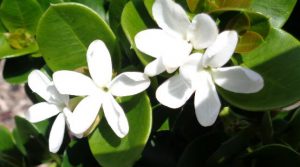
By Ralph E. Mitchell
I often wander through our Demonstration Garden at the East Port Environmental Campus on Harbor View Road in Port Charlotte to see what is blooming, producing fruit, or has a pest infestation. Our Natal plum specimen, also known as Carissa macrocarpa, was in full bloom and demanded my attention. Deep green glossy foliage, white flowers scented like orange blossoms, and red, cranberry-like fruit are characteristics which make this shrub a favorite in the landscape.
Noted for its tolerance to salty conditions and drought, this South African evergreen shrub likes full sun to part-shade and sandy, well-drained soil. While the species can grow up to twenty-feet tall, the cultivated types are smaller and can easily be pruned to shape. In addition to the leathery green leaves, there are spines up to two-inches long on the branches of most cultivars which can be a hazard to passersby, or a beneficial and effective barrier, depending on your perspective. The white sweet-smelling flowers have five waxy petals and are present year-round. The flowers are eventually followed by two-inch long oval red fruits which, when ripe, can be used as a cranberry substitute.
As a landscape plant, the Natal plum has a wide range of cultivars suitable for a variety of needs. For example, there are cultivars such as ‘Prostrata’ , ‘Horizontalis’, and ‘Green Carpet’ which can be grown as groundcovers. If you prefer thorn-less types, select ‘Boxwood Beauty’ or ‘Nana’ . Otherwise, unnamed cultivars can be easily pruned to keep them in bounds. In addition to its use as a groundcover, Natal plums make excellent screens or hedges when planted on four to five foot centers. Superior as a seaside planting, they also do well in containers, especially the truly dwarf varieties such as ‘Bonsai’ which will grow only about two-feet tall.
Now while the fully ripe fruit is edible, the unripe fruit and plant parts are considered to be a minor toxicity concern. Broken plant parts will bleed a milky sap which can be irritating to eyes. The ripe Natal plum fruit is reported to be a good source of Vitamin C with sixty milligrams in a cup of raw sliced fruits.
Like many drought-tolerant plants, the natal plum, once established, should not be over-watered as this can promote root rots. Otherwise, the Natal plum is one that you should try – another Florida-Friendly Landscaping™ plant! For more information on all type of shrubs suitable for our area, please call our Master Gardener volunteers on the Plant Lifeline on Mondays, Wednesdays and Fridays from 1 to 4 pm at 764-4340 for gardening help and insight into their role as an Extension volunteer. Don’t forget to visit our other County Plant Clinics in the area. Please check this link for a complete list of site locations, dates and times – http://charlotte.ifas.ufl.edu/horticulture/Plant%20Clinics%20Schedule.pdf.
Resources:
Gilman, E. F. (2014) Carissa macrocarpa Dwarf Natal Plum. The University of Florida Extension Service, IFAS.
Christman, S. (2003) Carissa macrocarpa. Floridata.com. Tallahassee, Fl.
The Florida-Friendly Landscaping Guide to Plant Selection & Landscape Design (2010) The University of Florida Extension Services, IFAS.
Simmone, A., Bobroff, L. B., Cooper, A., Poirier, S., Murphy, M., Oswald, M. J., & Procise, C. (2013) South Florida Tropicals: Carissa (Natal Plum) The University of Florida Extension Services, IFAS.
Safe and Poisonous Garden Plants (2017) Division of Agriculture and Natural Resources, University of California.
Morton, J. 1987. Carissa. p. 420–422. In: Fruits of warm climates. Julia F. Morton, Miami, FL.
 0
0

Comments are closed.